
Overdrive is the operation of an automobile cruising at sustained speed with reduced engine revolutions per minute (RPM), leading to better fuel consumption, lower noise, and lower wear. The term is ambiguous. The most fundamental meaning is that of an overall gear ratio between engine and wheels, such that the car is over-geared, and cannot reach its potential top speed, i.e. the car could travel faster if it were in a lower gear, with the engine turning at higher RPM.

A manual transmission (MT), also known as manual gearbox, standard transmission, or stick shift, is a multi-speed motor vehicle transmission system, where gear changes require the driver to manually select the gears by operating a gear stick and clutch.

In mechanical or automotive engineering, a freewheel or overrunning clutch is a device in a transmission that disengages the driveshaft from the driven shaft when the driven shaft rotates faster than the driveshaft. An overdrive is sometimes mistakenly called a freewheel, but is otherwise unrelated.

TorqueFlite is the trademarked name of Chrysler Corporation's automatic transmissions, starting with the three-speed unit introduced late in the 1956 model year as a successor to Chrysler's two-speed PowerFlite. In the 1990s, the TorqueFlite name was dropped in favor of alphanumeric designations, although the latest Chrysler eight-speed automatic transmission has revived the name.

The Panhard Dyna Z is a lightweight motor car produced by Panhard of France from 1954 to 1959. It was first presented to the press at a Paris restaurant named Les Ambassadeurs on 17 June 1953 and entered production the following year. In 1959, it was replaced by the Panhard PL 17.
The AW70 series is a group of 4-speed automatic transmissions built by Aisin-Warner, a Japanese-American joint venture company, for the Volvo 240, 740 and 940. There are three different models within the series, all based on the AW70, which was first used in 1981 Volvo models.

The Chevrolet Engineering Research Vehicle (CERV) is a series of Chevrolet experimental cars. Chevrolet Staff engineer, designer, and race car driver Zora Arkus-Duntov started development of the CERV I in 1959, and began work on the CERV II in 1963. Chevrolet chief engineer Don Runkle and Lotus' Tony Rudd discussed creating a new show car to demonstrate their engineering expertise in 1985; It would become the CERV III. Corvette chief engineer Dave Hill unveiled the CERV IV in 1993, a test vehicle for the 1997 C5 Corvette.
Vehicles made by American Motors Corporation (AMC) and Jeep incorporated a variety of transmissions and transfer case systems. This article covers transmissions used in the following vehicle models and years:

The TatraT813 was a truck produced in Czechoslovakia by the Tatra company. It was produced from 1967 to 1982. The basic representative of this series was a military version of the 8×8 Kolos (Colossus), which was able to pull trailers up to a total weight of 100 tons. Tatra also produced a civilian version in either 6×6 or 4×4. After fifteen years of production, 11,751 vehicles were built in all modifications. Many units were exported to the USSR, East Germany, Romania and India.
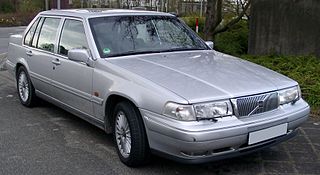
The Volvo 900 Series is a range of executive cars produced by the Swedish manufacturer Volvo Cars from 1990 to 1998. The 900 Series was introduced in 1990 to replace the 700 Series from which it derived. Prior to the end of its production, the 960 was renamed as the Volvo S90 (saloon) and Volvo V90 (estate), and the 940 was renamed 940 Classic, becoming the last rear-wheel-drive cars from Volvo, until the 2023 Volvo XC40.
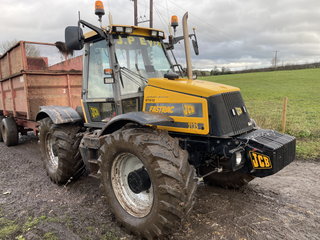
The JCB Fastrac is a high-speed agricultural tractor series manufactured by JCB Landpower, part of the JCB group.
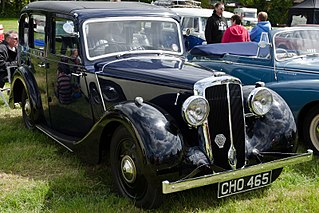
The Lanchester Fourteen Roadrider is a six-cylinder automobile introduced by the Lanchester Motor Company in the beginning of September 1936. It was named "Roadrider" for its special suspension features, and billed as the lowest-priced six-cylinder Lanchester ever offered. This car replaced the previous 12 hp Light Six model with a larger six-cylinder engine again in the Lanchester Eleven chassis and body.

A drivetrain is the group of components that deliver mechanical power from the prime mover to the driven components. In automotive engineering, the drivetrain is the components of a motor vehicle that deliver power to the drive wheels. This excludes the engine or motor that generates the power. In marine applications, the drive shaft will drive a propeller, thruster, or waterjet rather than a drive axle, while the actual engine might be similar to an automotive engine. Other machinery, equipment and vehicles may also use a drivetrain to deliver power from the engine(s) to the driven components.

Wilson-Pilcher was an English car company founded in 1901 and acquired by Sir WG Taken Armstrong Whitworth & Co., Limited in 1904.
The Audi R8 LMS Cup was a one-make sports car racing series by Audi based in Asia. Audi R8 LMS Cup cars were based on the Audi R8 LMS (GT3).

The Porsche-Diesel Standard 218, also known as N 218, is the third generation of the two-cylinder Standard tractor series, manufactured by Porsche-Diesel Motorenbau GmbH in Friedrichshafen am Bodensee. The Standard 218 was produced in four different variations. It succeeded its predecessor, the Porsche-Diesel 208 in 1957. In total, the Porsche plant produced more than 12,000 Standard 218 tractors from 1957 to 1963.
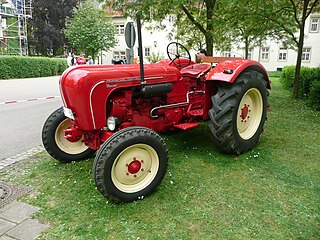
The Porsche-Diesel 419 is an agricultural tractor made by Porsche-Diesel Motorenbau, and part of Porsche's Master series. It was the biggest and most powerful series-production tractor ever sold under the Porsche brand. In total, 1175 units were produced from 1960 until 1963. The 419 was preceded by the 418, and had no successor, since Porsche-Diesel Motorenbau stopped producing tractors in 1963. That same year, the catalogue price for a Porsche-Diesel 419 was DM 15,290.

The Wesseler W 17 is an agricultural tractor made by H. Wesseler OHG. It is the firm's smallest two-cylinder model and was made from 1954 until 1956. In the Netherlands, the tractor was sold under the Vewema brand.
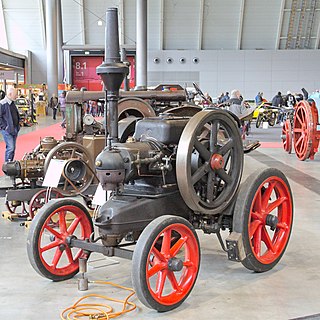
The Lanz HL, also known as Lanz Bulldog HL and Lanz Bulldog HL 12, is an agricultural machine and tractor made by Heinrich Lanz & Co. OHG. It was developed by German engineer Fritz Huber and is the first Lanz tractor to feature the "Bulldog" Akroyd engine. Thus, it is the first series production Lanz Bulldog. The Lanz HL was introduced at the 1921 DLG agriculture fair in Leipzig and stayed in production until 1927. In total, more than 6,000 units were made. The HL Bulldog engine was also sold as a stationary engine; this article primarily describes the HL agricultural tractor.
















